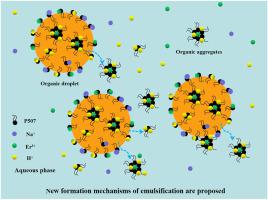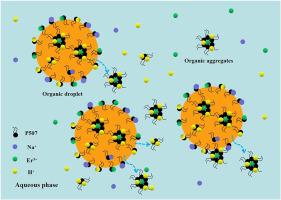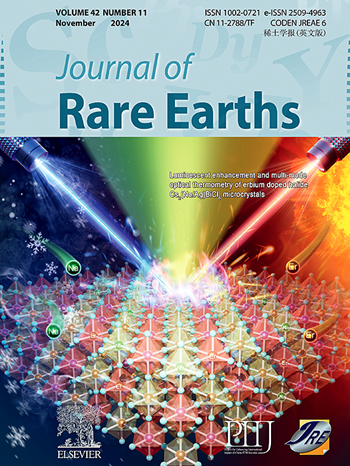酸性萃取剂萃取稀土过程中形成乳化的微观机制综述
IF 7.2
1区 化学
Q1 CHEMISTRY, APPLIED
引用次数: 0
摘要
溶剂萃取是分离和提纯稀土元素的主要方法。在稀土萃取过程中,由于水相和有机相不稳定或操作条件不当,经常会形成乳化现象。一旦发生乳化,不仅会导致稀土回收率低、产品数量少、生产成本高、萃取剂和稀土资源流失,还会造成严重的环境污染。因此,研究乳化的微观机理,建立从源头上防止乳化的新方法非常重要。本文综述了导致乳化的可能因素,如有机相和水相的组成和性质、稀土萃取的操作条件等。在此基础上,提出了乳化的新形成机制。初步探索验证了这些新观点的正确性。最后,提出了乳化微观机制研究的未来方向。本研究为进一步了解稀土萃取过程中界面不稳定导致乳化的微观机制提供了理论依据。本文章由计算机程序翻译,如有差异,请以英文原文为准。


Review on micro-mechanism of forming emulsification during rare earth extraction by acidic extractants
Solvent extraction is the main method used to separate and purify rare earth elements. In the process of rare earths extraction, emulsification often generated due to the instability of the aqueous and organic phases or improper operating conditions. Once emulsification occurs, it would not only lead to low rare earths recovery efficiency, small product quantities, high production costs and the losing of extractant and rare earth resources, but also result in serious environmental pollution. Therefore, it is very important to study the micro-mechanisms of emulsification and establish new methods to prevent emulsification at the source. In this paper, possible factors resulting in emulsification, such as the compositions and properties of the organic and aqueous phases, the operating conditions of the rare earths extraction are reviewed. The micro-mechanisms of emulsification are summarized basing on the microscopic structures in the bulk phase, aggregations of the extractants at the organic-aqueous interface, spectral characterizations and computational simulations. On this basis, new formation mechanisms are proposed for emulsification. Preliminary explorations are employed to verify the correctness of these new viewpoints. Finally, future directions for studies of the emulsification micro-mechanism are proposed. This study provides a theoretical basis for further understanding the micro-mechanisms of interfacial instability resulting in emulsification in the process of rare earths extraction.
求助全文
通过发布文献求助,成功后即可免费获取论文全文。
去求助
来源期刊

Journal of Rare Earths
化学-应用化学
CiteScore
8.70
自引率
14.30%
发文量
374
审稿时长
1.7 months
期刊介绍:
The Journal of Rare Earths reports studies on the 17 rare earth elements. It is a unique English-language learned journal that publishes works on various aspects of basic theory and applied science in the field of rare earths (RE). The journal accepts original high-quality original research papers and review articles with inventive content, and complete experimental data. It represents high academic standards and new progress in the RE field. Due to the advantage of abundant RE resources of China, the research on RE develops very actively, and papers on the latest progress in this field emerge every year. It is not only an important resource in which technicians publish and obtain their latest research results on RE, but also an important way of reflecting the updated progress in RE research field.
The Journal of Rare Earths covers all research and application of RE rare earths including spectroscopy, luminescence and phosphors, rare earth catalysis, magnetism and magnetic materials, advanced rare earth materials, RE chemistry & hydrometallurgy, RE metallography & pyrometallurgy, RE new materials, RE solid state physics & solid state chemistry, rare earth applications, RE analysis & test, RE geology & ore dressing, etc.
 求助内容:
求助内容: 应助结果提醒方式:
应助结果提醒方式:


